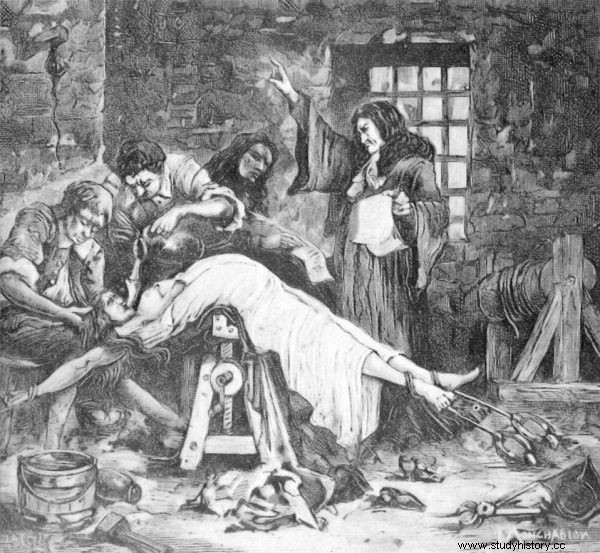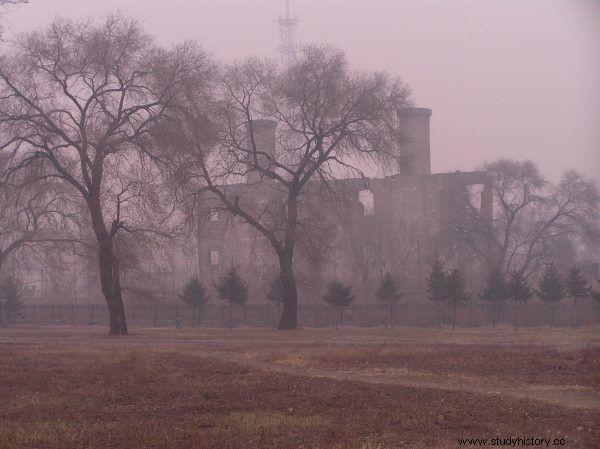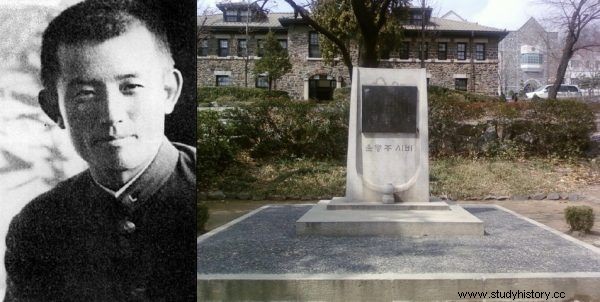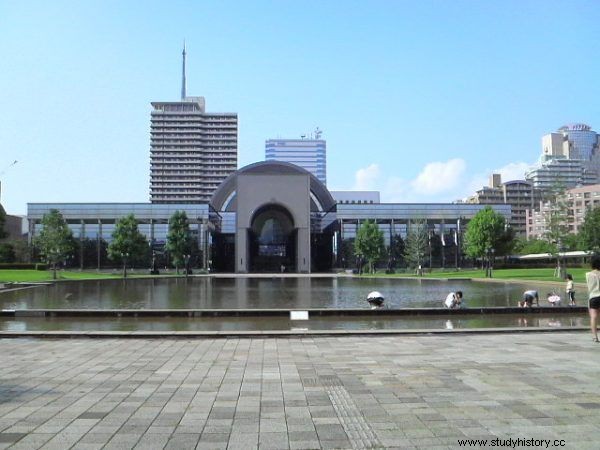Hunger, fear, humiliation, torture, disease and death. In Japanese POW camps, every sunrise announced hard labor. And each day ended - it seemed like a miracle.
After the attack on Pearl Harbor, on December 7, 1941, Japanese forces began a rapid conquest of Asia and the Pacific islands. In the face of the historic empire-building mission, the government could not afford any signs of anarchy. There was a massive campaign of repression in the country. Communists and opponents of the aggressive regime were persecuted. The main weapon of the dictatorship was the Kempeitai. Secret, ruthless and boundlessly obedient political police. 
Unreasonable subjects ended up behind the barbed wire of the camps. Nobody even made up an excuse for exile. One gesture or word was enough to be in a place worse than hell itself.
One such camp was the prison in Fukuoka, located on the Japanese island of Kyushu. All the enemies of the Japanese government and Emperor Hirohito himself were sent there. Koreans, Chinese, Americans. The largest group of prisoners, however, were native Japanese.

The uniform of a Kempeitai officer, or the Japanese secret police, on display at the Hong Kong Coastal Defense Museum (photo by Ahoiyin, license CC BY-SA 3.0).
The prisoners had no rights. Condemned to the grace (or disgrace) of the camp guards, they felt the breath of death on them every day. The same death that was their only salvation for most of them.
Torture for all occasions
The enemies of the motherland were found guilty as soon as they arrived at the camp. It was only a matter of time before pleading guilty, and the secret interrogations were to help. When they failed and the inmate's resistance was greater than expected - it was time for torture.
In terms of brutality and ferocity, the Japanese guards were in no way inferior to the barbaric executioners of the SS and Gestapo. One of their favorite tortures was the so-called "rice torture", consisting in starving the victim for several days. Then the prisoner was fed dry rice, which he had to wash down with plenty of water. The rice that swelled in the stomach caused great pain.
Another method of "breaking" a person was "water" torture. Water was poured into the victim's lungs through the mouth or nose. After she lost consciousness, the executioner jumped on the prisoner's belly until the water ran out again. This procedure was usually repeated several times.
Sadistic watchmen competed in inventing all sorts of ways to inflict pain on their victims. They didn't need any reason. Just like that, only to satisfy their sick desires, extinguished cigarettes, candles or red-hot iron rods on the bodies of prisoners. Boiling water and burning oil were also popular torture devices. They were poured over the most sensitive parts of the body - nose, ears, abdomen and genitals.

Water torture was popular not only in Japan (source:public domain).
Pulling out nails, cutting fingers, electric shocks, forcing to kneel for several hours on broken glass, stretching knee and elbow joints, breaking limbs and ribs, sticking splinters under the nails - all these belonged to the "iron repertoire" of prison sadists in uniform.
When a smile becomes a crime
Torture could be encountered at any time of the day or night. Most often, the prisoner did not even find out why he would be subjected to them. And in this way even the smallest offenses were punished. It was forbidden to talk to fellow prisoners. Any contact with another human was punishable. It was forbidden to sing, whistle, draw and write in the POW camp. Each art form was severely punished. Even a smile has become a serious offense.
The most serious offense, however, was disrespecting the guard. Failure to bow and salute meant immediate repression in the form of hours of hard labor. The lightest punishment seemed to be forcing the prisoner to stand at attention in front of the guard's house all day long. Even the slightest movement was flogging.
Each of the guards received a salary of 20 yen (increased to 40 after 1944) and cigarettes. However, not all of them were a sadist and psychopath. There were also those who established contacts with prisoners and helped them get additional food. Sometimes they were also allowed to write a letter to the family. However, not more often than once every 10 weeks. The condition was to describe the stay in the camp in superlatives.
Survive for a handful of rice
The conditions in which the prisoners lived were terrible. Most people slept on the floor, and paper mats served as the bed. They were covered with a heavy cotton blanket. In the cramped barracks, the heads of sleeping people were located right next to holes dug in the ground, serving as a toilet emptied every two weeks. Each barrack was equipped with one, most often a 15-watt light bulb.

This is what American and Dutch soldiers looked like after a few months in a Japanese camp in Thailand (source:Australian War Memorial, public domain).
Baths took place in a separate building and were rare. Sometimes the water was heated during the winter months. One could only dream of soap. The possibility of bathing in natural water reservoirs, such as rivers or lakes, was also used, but only in the colder periods of the year. In summer, such practices were banned - allegedly due to the risk of skin diseases.
People who could not work were condemned to starving food. Every day they got a small cup of the worst quality dry rice. Malnutrition often led to serious diseases.
Prisoners assigned to inhuman work in forests or quarries received higher portions. These included, in addition to rice (about 700 grams a day), a watery vegetable soup made from anything else we could find nearby.
The most productive workers were given an additional three small rolls every other day, which they could take with them to work. Due to malnutrition, all prisoners looked like skeletons. Work was carried out under inhumane conditions, usually from dawn to dusk. Forests were cut, river beds widened, or a railway was built. The strongest prisoners were sent to work in the quarries.
Humanity as the only medicine
The sick were sent to a makeshift room where there was a strong smell of disinfectants. Due to the lack of drugs and medical tools, no one specifically dealt with the treatment of diseases. Each prisoner who landed in the infirmary could only wait for death. The medical staff was more interested in examining the cadavers and making all sorts of experiments and medical experiments. Anyway, live "specimens" were also sent to the latter!

Ruins of a building where Japanese biological weapons were developed - also based on experiments on prisoners (photo 松岡明 芳, license CC BY-SA 3.0).
The conditions were slightly better in the barracks for American prisoners of war, who were most often pilots shot down during the fighting over Japan. Those soldiers who knew medicine could look after and heal their sick colleagues, but they had no tools at their disposal. They didn't even have painkillers.
Diseases were ubiquitous. Malaria and dysentery (dysentery) decimated the population in the camps cruelly and systematically. Patients lay fat on their own, clotted blood, vomit and faeces. The bodies of the dying were covered with ulcers and rotting wounds with swarms of insects. The sight was terrifying.
The only salvation for some prisoners was forging friendships between comrades in misery. In the most difficult moments, people helped each other endure hardships and diseases. Whenever possible, support was given, food and work were shared.
A man, a prisoner, a poet
For the guards, the prisoners were only numbers. They had no personality, no individual characteristics. Among these prisoners, however, there was a man who kept his humanity until the last moments of his life, becoming a hero of the inhuman world.
That person was Yun Dong-Ju, one of the greatest Korean poets of the 20th century. He already showed talent as a young boy. After graduation, he wanted to publish his first book of poetry, but the poems were censored because the message was too obvious, and it was against the Japanese invader.

Yun Dong-Ju, one of the greatest Korean poets of the 20th century, survived the hell of the Japanese camps. On the left, a photo of him, when he was about 24 years old (source:public domain), on the right, a monument to his poem at Yonsei University (photo:Yknok29, license CC-BY-SA-3.0).
He changed his name to Hiranuma to make it easier for him to study in Tokyo. His poetry was still full of anti-government references, and for this reason Yun Dong-Ju was arrested in 1943. A year later, he was accused of crimes of a political nature. As a "dangerous and subversive element", that is, a member of the Korean independence movement, he was sentenced to two years in prison in the already known camp in Fukuoka.
Intimidated, tortured and humiliated, he died on February 16, 1945. The causes of his death are shrouded in mystery. He probably became a victim of inhuman medical experiments, like other Koreans at the Fukuoka camp. The poet's relatives only received the cremated ashes that were buried in the family cemetery.

Years later, Fukuoka does not resemble the extermination site of numerous prisoners. The photo shows Fukuoka City Museum (photo:Mmry0241, license CC BY-SA 3.0).
Three years after the war, Yun Dong-Ju's collection of poems, entitled "Heaven, Wind, Stars and Poetry" was published for the first time. It was not until the 1980s that the camp documents about Yun were published. After many years, the repressed poet finally received the recognition he deserved. Today, he is considered one of the most respected artists in the country. His poetry is taught in schools and his poems are known to every Korean student.
After Japan's surrender and the end of World War II in the Pacific, the vast majority of cruel Japanese prisoner of war guards did not share the fate of their Nazi counterparts and escaped from justice. In trials, they were only regarded as executors of orders. Not guilty convictions were common. Despite their incredible barbarism, they did not suffer punishment and lived to the end of their days, enjoying what they deprived of their prisoners - freedom.
The Americans went so far as to say that the crimes committed by the Japanese were not as despicable and cruel as the crimes committed by the Nazis tried at Nuremberg. Former prisoners of Japanese camps never came to terms with this sentence. As you can see, justice after the war had many faces…
